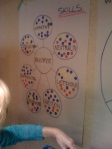A few weeks ago I took a one-day course on the topic of business facilitation. When I shared what I was up to on a Social Media site at work, a few people asked me to report back on how I found it; presumably to help them decide whether it would be worth their time as well. Many reading this might not have access to this particular course; however, I have found that book reviews valuable even if I don’t intend to ever read the featured book.
In that spirit, here are my thoughts regarding this workshop:
- Pre-readings are an awesome idea. I know we’re all busy and for some the imposition of pre-work is nasty business. However, I appreciated the assignment for the very reason that even though facilitation is a main pillar of my practice and I enjoy doing it, I rarely seem to have time to explore it’s theory. This homework was the direction I needed to carve out some guilt-free dedicated learning time. I also liked that the material was well written, easy to read, and the estimated time to digest it was exactly as advertised. As a course designer, I always felt a pre-session exercise was a great way to engage participants before they stepped into the classroom. As a learner, I can see how a pre-reading can make the learning experience a better offering by elevating past the fundamentals and into the meat of a topic.
- Solidly define the topic.
While it was covered in the pre-reading, one of the first things the instructor did was to confirm common understanding of the topic. Facilitation is a commonly used word in business with a myriad of perceptions of what it is. For us, it was explained that facilitation is a style of presentation that is based on inquiry (asking questions) and is different than instruction that typically involves the transfer of knowledge from a subject matter expert. Several years ago, Dawn Miller, an accomplished public speaker and businesswomen, explained to me that public speaking can be thought of a continuum between keynote presenting and facilitation this has always helped me understand this concept. A continuum was also offered to us, although the bookends were training and coaching with facilitation in the middle.
- Get people involved – early.
Next we did a ground rules exercise that is typical for workshops and meetings involving participant interaction. I liked that it was demonstrated but what I found most valuable was the instructor asked for a participant volunteer to lead it. Immediately after, we did an exercise that called for a creative report-out that got everyone in front of the plenary group – which is exactly what facilitators are called on to do.
- Use visual thinking. The pre-reading asked us to do two self-assessments exercises – one to narrow our specific learning areas
and the other to help us identify our preferred facilitation
style. I found these exercises a valuable way to engage with the course material and helped us understand the concepts. However, how we explored it during the workshop was unique, we simply put up some sticky dots on a flip chart to indicate our answers. Not only did this take very little in-course time, but it also appealed to me as a visual learner.
- Let people hold the product. This is a popular sales technique but it also works in the leaning and education realm. Just before lunch participants were split up into breakout groups and were instructed to choose one of 5 problem solving tools described during the pre-reading. Then we had an hour to develop a 15 facilitated session exploring a problem of our choice. I enjoyed this exercise because it gave me the opportunity to facilitate using a tool that I had not used before while incorporating the theory learned so far. Not only did the exercise provide an excellent practice “rep” in a supportive environment of fellow learners, but we also took a few minutes afterwards to debrief the exercise and share feedback. We took turns in our group being a dedicated observer and Mark Bell’s Feedback Model was suggested to provide feedback in a structured format.
While I completely enjoyed the workshop, I thought it would be even if there was a section available for participants to share their facilitation “best practices.” However, as this course was intended to be introductory, this might be an unrealistic request. Perhaps it’s better suited for either a “200” level course or a community of practice session.
Other participants were concerned about the limited amount of in-session time to prepare their facilitated sessions. While the exercise was explained in the pre-reading, the problem-solving tool that each person was to use was chosen in a group discussion during the session. If this discussion were to be held in a virtual meeting prior to the course, that might give these participants more time to prepare.
Above all, this educational opportunity was a day well spent exploring and learning the powerful skill and art of facilitation. If you have follow-up questions or comments on this course review or the topic of facilitation – comment below, tweet me @gsjonuk, or email me at thejonuks@shaw.ca





Thanks Greg for your very detailed review of the course. As one of the developers and facilitators of this course, feedback like yours is incredibly valuable to us. We feel that we have hit the objectives that we set out to achieve. A hands on, highly interactive learning experience giving public servants some tools and some skills to help them achieve results in thier workplaces.
thanks again for your feedback…!
David